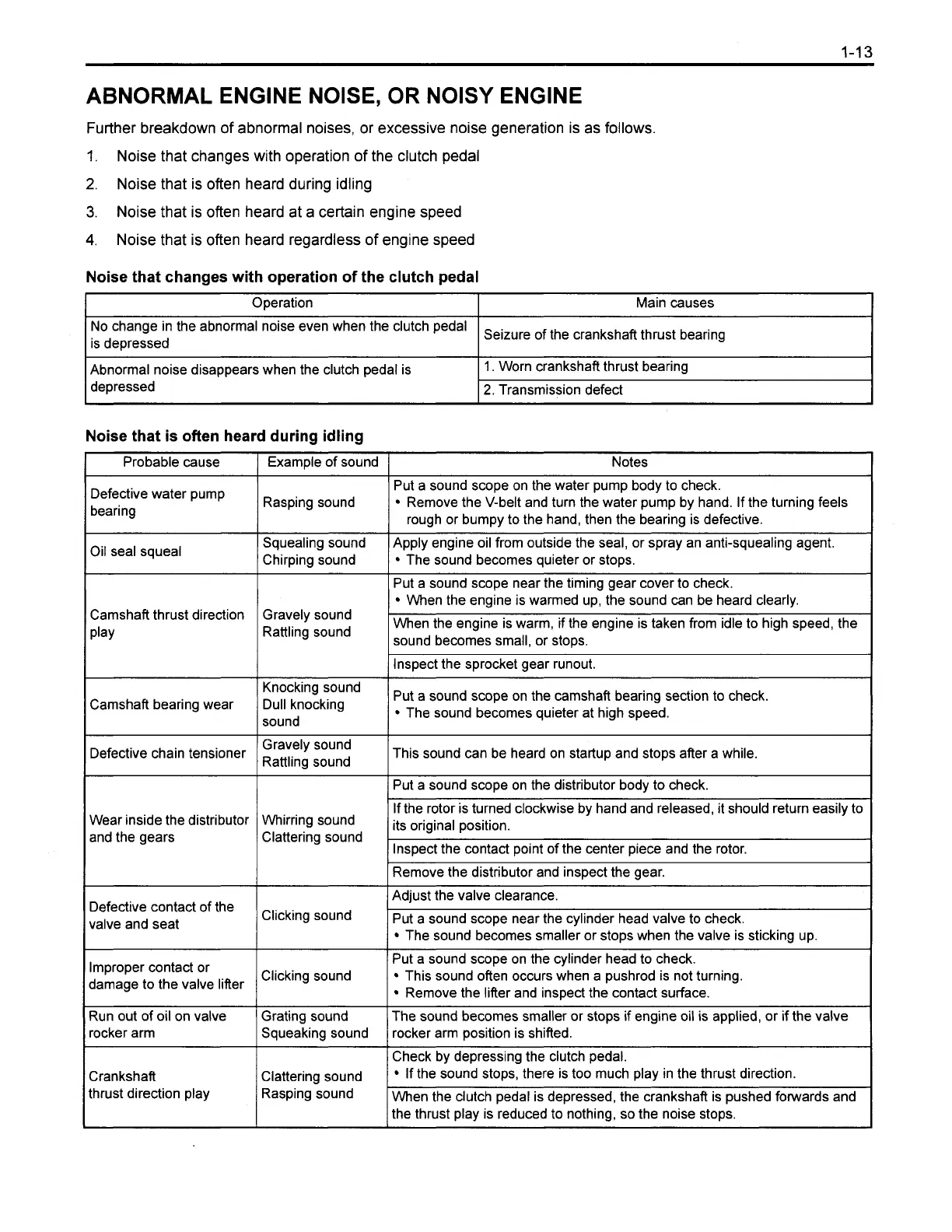ABNORMAL ENGINE NOISE, OR NOISY ENGINE
Further breakdown of abnormal noises, or excessive noise generation is as follows.
1.
Noise that changes with operation of the clutch pedal
2.
Noise that is often heard during idling
3.
Noise that is often heard at a certain engine speed
4.
Noise that is often heard regardless of engine speed
I
No change in the abnormal noise even when the clutch pedal
I
Seizure of the crankshaft thrust bearing
is depressed
Noise that changes with operation of the clutch pedal
Operation
Noise that is often heard during idling
Main causes
Abnormal noise disappears when the clutch pedal is
depressed
Probable cause
I
Example of sound
1.
Worn crankshaft thrust bearing
2.
Transmission defect
Defective water pump
Rasping
sound
bearing
Oil seal squeal
Squealing sound
Chirping sound
Rattling sound
Defective chain tensioner
Rattling
sound
I
GravelY
Camshaft bearing wear
Knocking sound
Dull knocking
sound
Wear inside the distributor
and the gears
Whirring sound
Clattering sound
Defective contact of the
valve and seat
Run out of oil on valve
Grating sound
rocker arm Squeaking sound
Clicking sound
Improper contact or
damage to the valve lifter
Crankshaft
thrust direction play
Clicking sound
Clattering sound
Rasping sound
Notes
Put a sound scope on the water pump body to check.
Remove the V-belt and turn the water pump by hand. If the turning feels
rough or bumpy to the hand, then the bearing is defective.
Apply engine oil from outside the seal, or spray an anti-squealing agent.
The sound becomes quieter or stops.
Put a sound scope near the timing gear cover to check.
When the engine is warmed up, the sound can be heard clearly.
When the engine is warm, if the engine is taken from idle to high speed, the
sound becomes small, or stops.
Inspect the sprocket gear runout.
Put a sound scope on the camshaft bearing section to check.
The sound becomes quieter at high speed.
This sound can be heard on startup and stops after a while.
Put a sound scope on the distributor body to check.
If the rotor is turned clockwise by hand and released, it should return easily to
its original position.
Inspect the contact point of the center piece and the rotor.
Remove the distributor and inspect the gear.
Adjust the valve clearance.
Put a sound scope near the cylinder head valve to check.
The sound becomes smaller or stops when the valve is sticking up.
Put a sound scope on the cylinder head to check.
This sound often occurs when a pushrod is not turning.
Remove the lifter and inspect the contact surface.
The sound becomes smaller or stops if engine oil is applied, or if the valve
rocker arm position is shifted.
Check by depressing the clutch pedal.
If the sound stops, there is too much play in the thrust direction.
When the clutch pedal is depressed, the crankshaft is pushed forwards and
the thrust play is reduced to nothing, so the noise stops.
